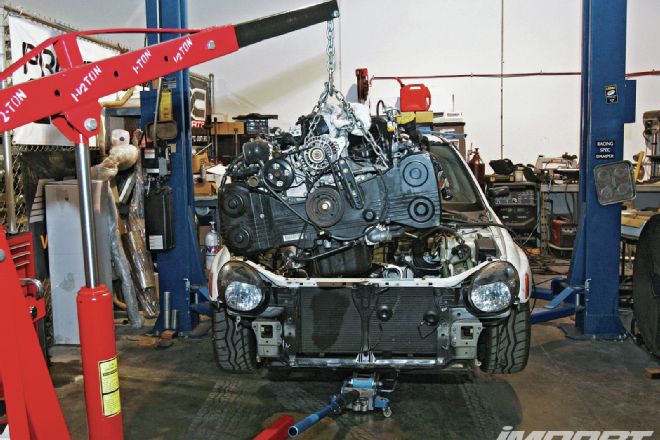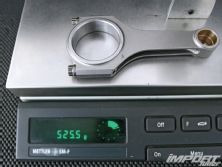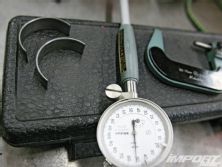Owning a ’03 WRX and a ’05 STI has both its perks and downfalls depending on how you look at it. There’s a great sense of pride when both my cars are running in perfect condition but that spectacular feeling came to an abrupt end during a dyno session a few years back when my ’03 WRX blew a head gasket. After deliberating for a good year after the gasket failure on how to attack the rebuild, I decided rather than fix the problem, I’d fortify the engine using forged internals to improve the engine’s reliability. Follow along as we document the better part of two years, building the long-block. Why so long you ask? It’s simple: Money doesn’t grow on trees.
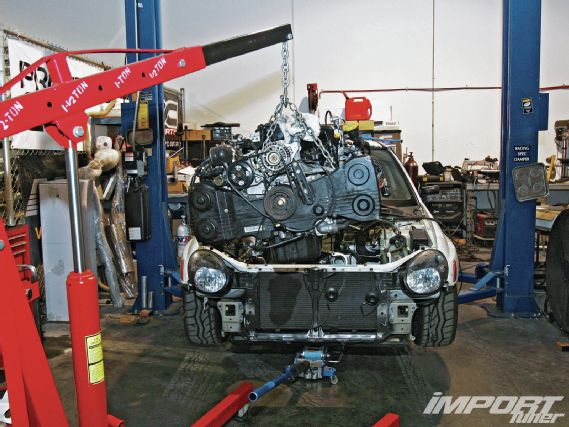 |
Project Subaru EJ205 - Build Log
|
Project Subaru EJ205 - Build Log
01 After a bout of overheating issues and coolant purging from the reservoir, a leakdown test revealed our stock EJ205 had seen its last run with a blown head gasket.
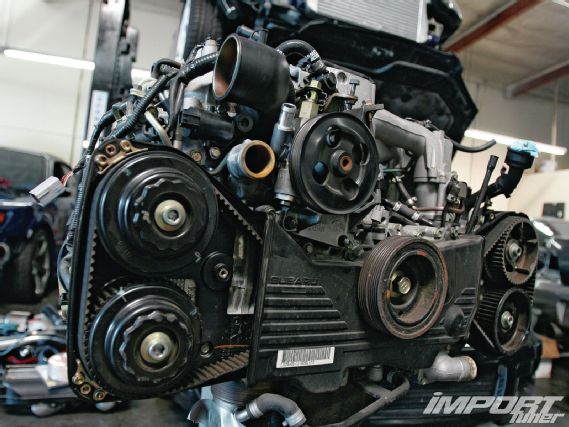 |
Project Subaru EJ205 - Build Log
|
Project Subaru EJ205 - Build Log
02 Upon tearing down the engine and removal of the cylinder heads, it was evident that engine oil was mixing with coolant.
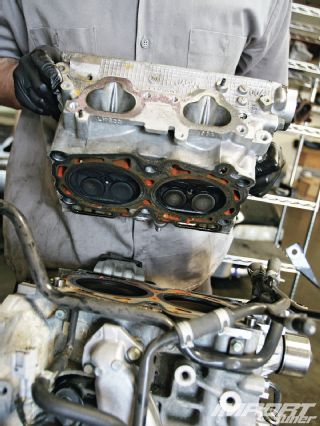 |
Project Subaru EJ205 - Build Log
|
Project Subaru EJ205 - Build Log
03 It was only a matter of time before the combination of high boost, aftermarket turbo, and stock engine internals would eventually cause the motor to pop. Notice the thick blobs of residue caused from using Dex-cool radiator coolant. Dex-cool antifreeze uses one of two inhibitors: Sebacate and 2-EHA (2-ethylhexanoic acid), which works well with the hard water found in the United States, but is a plasticizer that has been known to cause gaskets to leak.
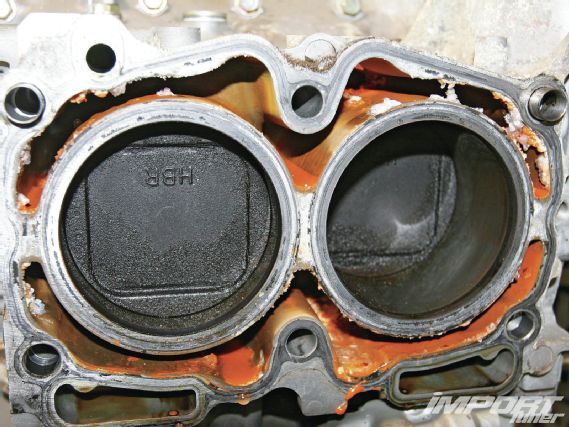 |
Project Subaru EJ205 - Build Log
|
Project Subaru EJ205 - Build Log
04 Subaru does not recommend running GM Dex-cool or any OAT-based (Organic Acid Technology) extended-life coolants. The main reason to stay away from these types of coolant is the glopping, or the thick gel-type effect as seen in the photo. Glopping usually occurs when air is in the coolant system and corrosion occurs on the aluminum parts in the engine. Coolant then washes over the corrosion, causing a glopping effect to occur. Using a phosphate and silicate-free coolant is the best solution for most aluminum engines.
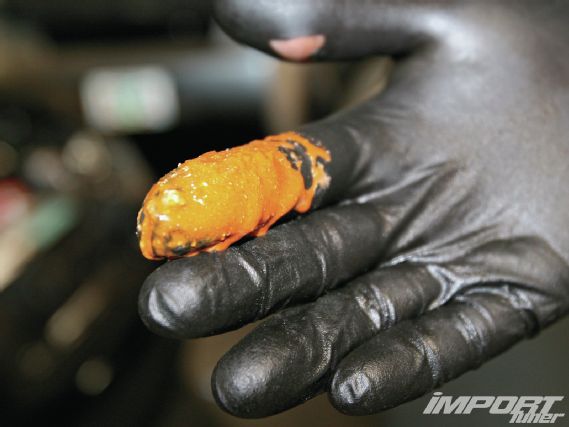 |
Project Subaru EJ205 - Build Log
|
Project Subaru EJ205 - Build Log
05 Analyzing the freshly removed pistons will reveal plenty about the condition of your engine and its health. Heavy scuff marks or scoring on the piston skirts indicates unmixed fuel has washed the oil away from the cylinder walls while a more severe case of scoring can be caused from heat seizing. The case of peppered markings or indentations across the tops of the pistons indicates detonation/pinging, while a melted piston is caused from an excessively lean air/fuel ratio.
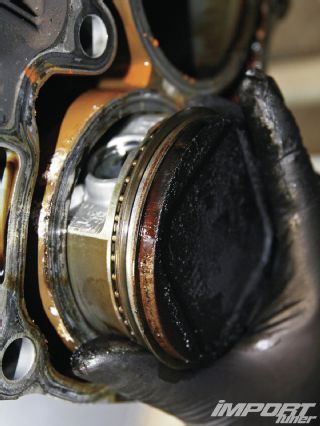 |
Project Subaru EJ205 - Build Log
|
Project Subaru EJ205 - Build Log
06 Howard Watanabe of Technosquare Tuning, located in Torrance, CA, visually inspected the crankshaft along with the rod and main bearings for any unusual wear and/or scoring. We are happy to report that all the parts were within acceptable tolerances.
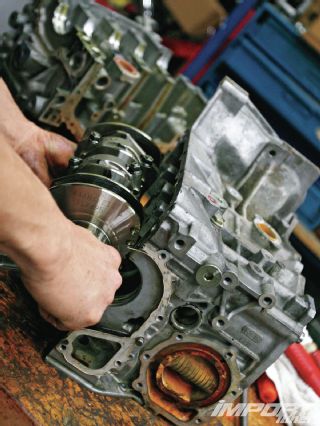 |
Project Subaru EJ205 - Build Log
|
Project Subaru EJ205 - Build Log
07 When building any engine, it’s important to refer to the manufacturer’s specification card, along with using the proper tools to take proper measurements.
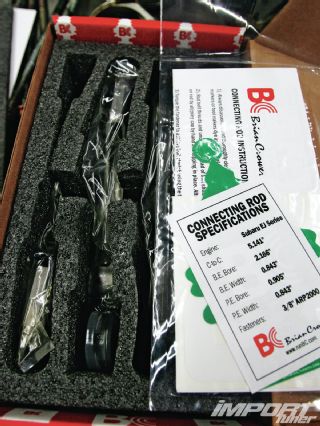 |
Project Subaru EJ205 - Build Log
|
Project Subaru EJ205 - Build Log
08 For our build, we used a set of BC (Brian Crower) connecting rods. The BC625+ rods use ARP bolts to deliver the ultimate clamping ability at high horsepower and rpm and is rated in excess of 300 hp per cylinder. Pictured is a comparison of the stock versus BC connecting rod.
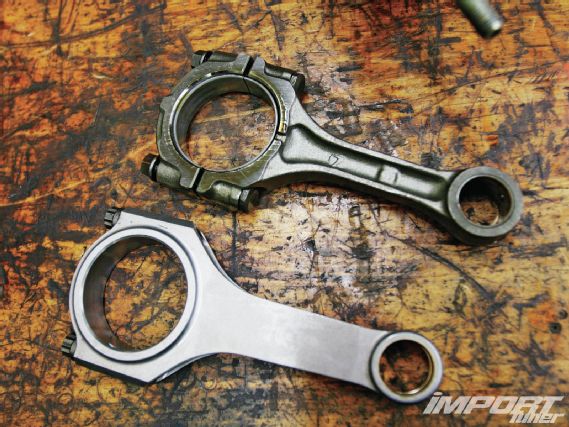 |
Project Subaru EJ205 - Build Log
|
Project Subaru EJ205 - Build Log
09 The stock cast pistons and factory I-beam rods were tossed aside in favor of more boost-friendly components.
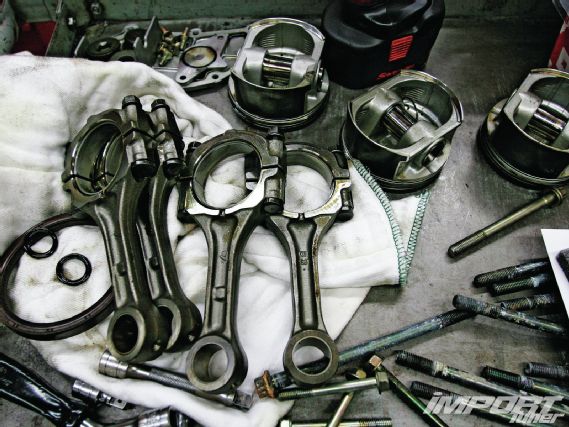 |
Project Subaru EJ205 - Build Log
|
Project Subaru EJ205 - Build Log
10 A micrometer is a measuring instrument that is used to determine the thickness of blocks, depths of slots, and diameters of shaft. Engine builders rely heavily on taking the proper measurements when checking tolerances to ensure the parts are within acceptable specifications.
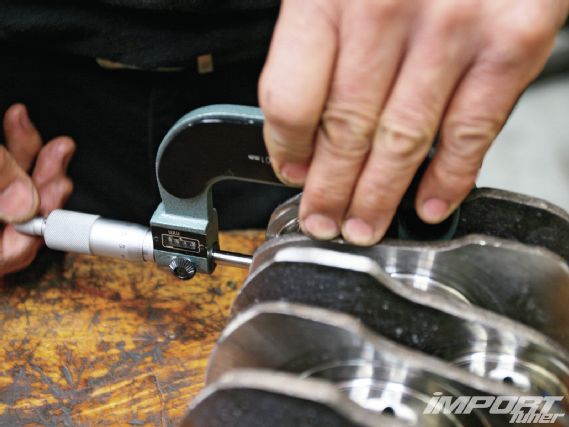 |
Project Subaru EJ205 - Build Log
|
Project Subaru EJ205 - Build Log
11 A dial or bore gauge is a very accurate and precise measurement tool that is used to check rod and main bearing clearances as well as piston-to-wall clearances. Every engine builder should own this tool
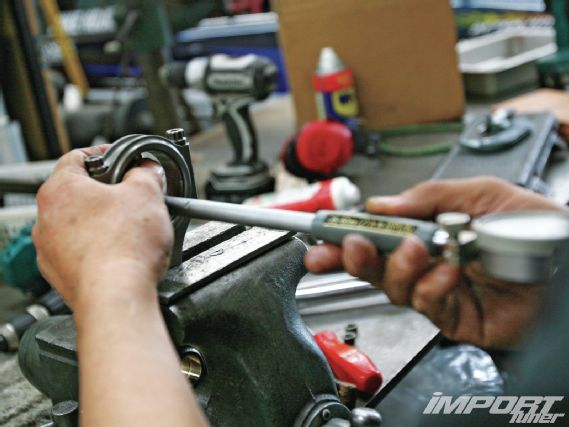 |
Project Subaru EJ205 - Build Log
|
Project Subaru EJ205 - Build Log
12 For the connecting rods, we used a set of ACL bearings with Calico’s CT-1 dry film lubricating coating. CT-1 coated engine bearings have greatly extended service life over uncoated bearings. Engine builders have also seen reduced damage in engines from heat- and lubrication-related failures
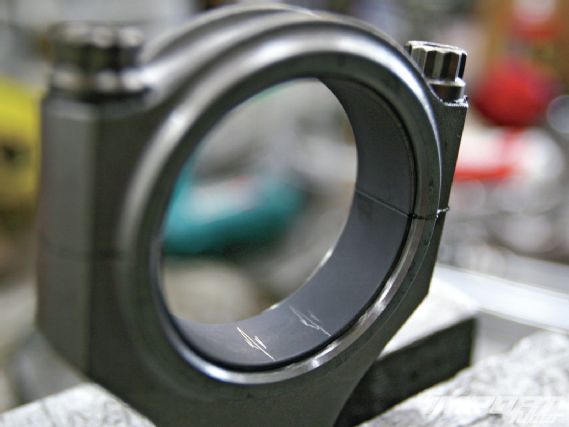 |
Project Subaru EJ205 - Build Log
|
Project Subaru EJ205 - Build Log
13 Larry Revis of Revco Precision, located in Long Beach, CA, machined and balanced our engine assembly. Revco does everything from polishing, balancing, and knife edging to straightening, strengthening, and machining. They do it all. Using a connecting rod balance scale, Revis carefully weighed each rod. This specialized scale is accurate up to 4,000 grams and has the ability to check weight on both big and small ends of the rod.
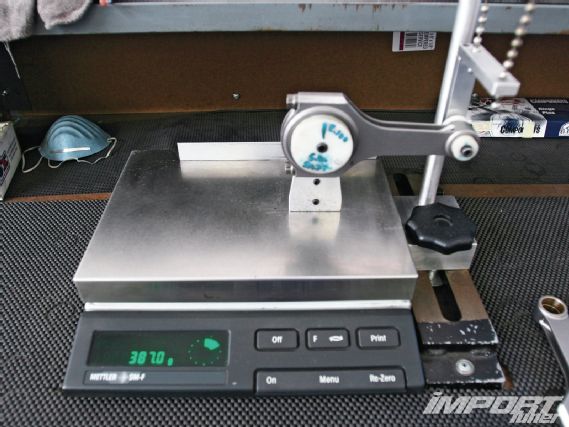 |
Project Subaru EJ205 - Build Log
|
Project Subaru EJ205 - Build Log
14 Notice the difference in weight on the scale when measuring the small end of the rod. Weighing a connecting rod using this type of scale will determine how much weight to remove and from what side of the rod. A perfectly balanced rod is a key component inside an engine that is spinning 8,000 rpm.
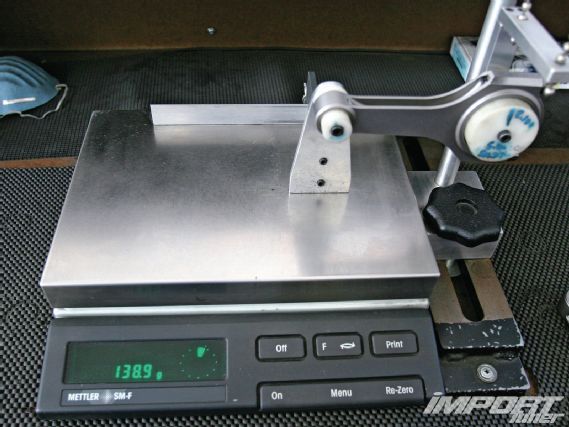 |
Project Subaru EJ205 - Build Log
|
Project Subaru EJ205 - Build Log
15 Racing pistons are a must for Subaru motors producing more than 400 hp. The heat and stress high-boost applications produce can destroy a stock Subaru cast piston over time. JE 2618 alloy forged pistons offer superior strength and durability—far more resilient than stock pistons. We used a set of .020 over pistons with an 8.5:1 compression ratio.
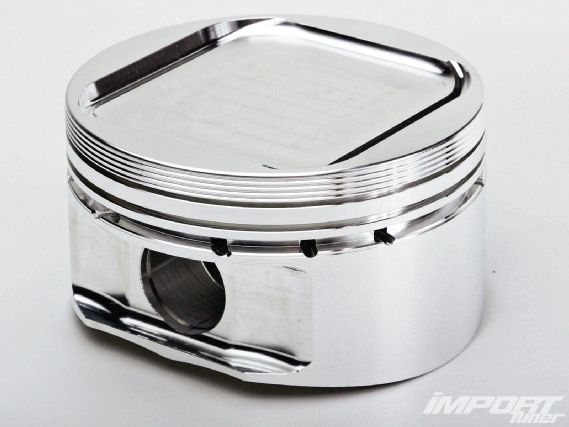 |
Project Subaru EJ205 - Build Log
|
Project Subaru EJ205 - Build Log
16 Similar to our connecting rod, each JE piston was carefully weighed and machined to perfectly match weight for all four.
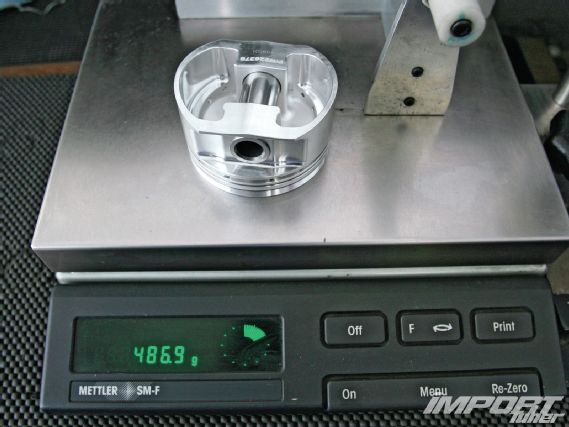 |
Project Subaru EJ205 - Build Log
|
Project Subaru EJ205 - Build Log
17 Prior to any machine work performed, the crankshaft is Magnafluxed using a special solvent, then magnetized. The magnet attracts the fluid to a centralized area if any cracks are present on the surface. The same process can be used on the connecting rods, block, cylinder head, and pistons.
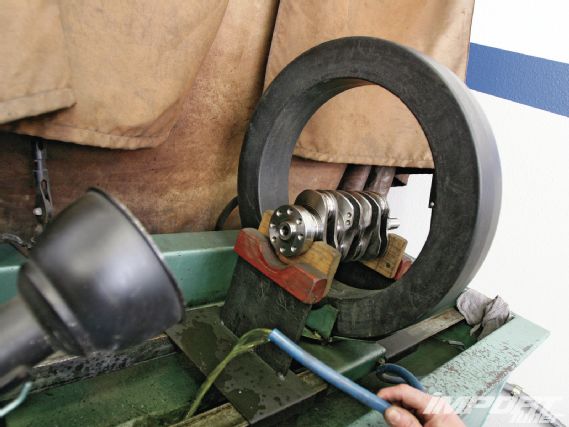 |
Project Subaru EJ205 - Build Log
|
Project Subaru EJ205 - Build Log
18 Once the crankshaft has passed the Magnaflux-testing phase, it’s then taken and inspected for straightness. “A normal crank varies from dead-on to being bent by five thousandths. If the crank is damaged or encountered a spun journal there’s a good chance it will be bent anywhere from 10 to 30 thousandths. Aftermarket crankshafts should always be inspected regardless—even if they are new. After final polishing, the crankshaft is Magnafluxed again and measured for precision.
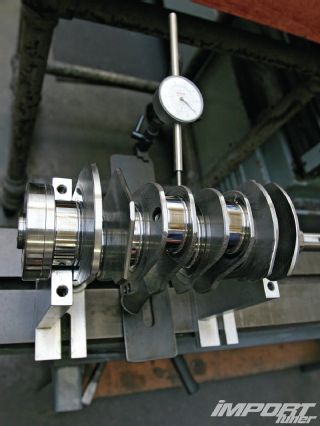 |
Project Subaru EJ205 - Build Log
|
Project Subaru EJ205 - Build Log
19 Revco Precision checks for crankshaft straightness, performing a simple technique of stress relieving the metal while straightening out the crankshaft to allowable tolerance. “A lot of guys won’t do the stress relief, and they wonder why their crankshafts crack prematurely,” Revis says. In performance applications such as our EJ205, the crank was balanced to within 0.1 thousandths of a gram. Too often we hear the horror stories of improperly balanced factory and aftermarket crankshafts breaking into pieces and ruining a perfectly good engine.
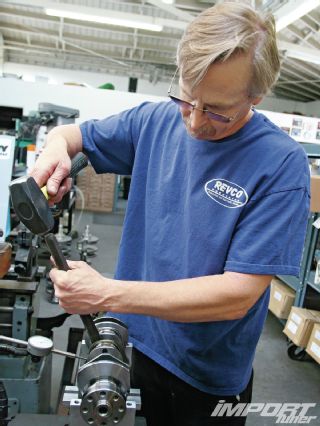 |
Project Subaru EJ205 - Build Log
|
Project Subaru EJ205 - Build Log
20 Nearing the final stages of servicing the factory crank, the journals are polished using a handheld polishing machine using an emery belt.
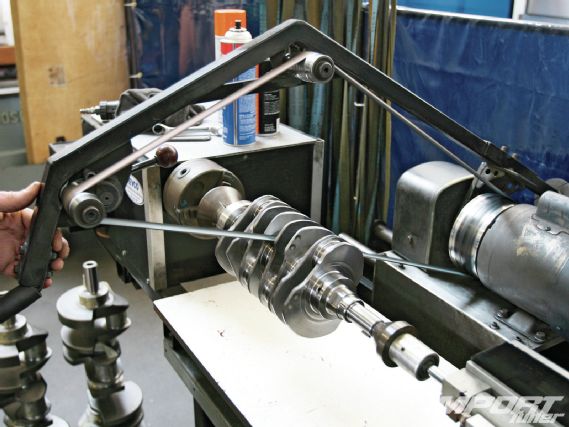 |
Project Subaru EJ205 - Build Log
|
Project Subaru EJ205 - Build Log
21 Engine Supply located in Santa Ana, CA, machined the block for the new JE pistons. Using a torque/honing plate is an essential piece when machining your engine block. The EJ20/EJ25 block is a lightweight aluminum casting. The stress of the cylinder head bolted to the block becomes an important factor in the block’s integrity. We used a deck plate to re-create that stress when boring and honing to eliminate distortion of the cylinder bore. We advise never dropping in a set of aftermarket pistons into a Subaru block without performing the proper machining.
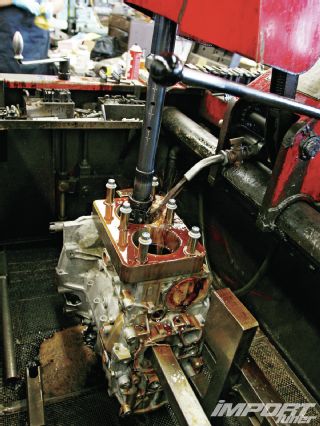 |
Project Subaru EJ205 - Build Log
|
Project Subaru EJ205 - Build Log
Stay tuned for part two of our project build as we rework the factory cylinder heads and prep the block for the final engine assembly, along with some dyno numbers to follow.
Got a unique project of your own that you feel deserves some attention? Whether it’s finished or years away from completion, we’d love to feature steps of your build. Shoot us an email and photo of your project at features@importtuner.com.

